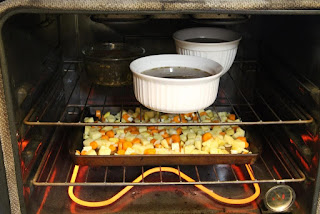A couple weeks ago,
we wrote that we were pitting the three types of corned venison we've made for past St. Patty's Days against each other in a head-to-head competition. After two weeks of marinating and trash talking in the fridge, Saturday night was finally fight night for our corned beast death match. Time for the contestants to put their money where our mouth is.
The three curing recipes had identical seasonings except for the liquids; one was a dry rub, one was a brine made with whey, and one was a brine made with apple cider vinegar. The cooking process was also similar for all three recipes: empty the meat plus all the cure ingredients into an oven-safe bowl, rinse the cure bag out with water, and add additional water as necessary to cover the meat. Then bake at 350 °F until well-done (meat internal temperatures actually reached 185-190 °F); total time in the oven was about an hour.
The taste tests had two parts:
ex-reubo tasting and
in-reubo tasting, which are Latin-sounding terms we invented to mean 'out-of-the-reuben (sandwich)' and 'in-the-reuben,' analogous to
in-situ (or
in-vivo) and
ex-situ.
Ex-reubo was just a bite of the cooked beast;
in-reubo was obviously in the sandwich, along with Swiss cheese, sauerkraut, and thousand island dressing on rye bread.
Somewhat to our surprise, there was a clear winner in this epic battle. Which recipe emerged victorious? Read on to find out!
 |
| Fresh out of the cure stage, they look pretty similar. The dry rub is maybe a little darker, and the whey-brined meat is more squishy. |
 |
| Here they are, warming up for the fight. A pan of roasted root veggies is ready to make sure any boil overs aren't wasted. |
 |
| Post-cooking, they also look pretty similar. There is less foam with the dry rub, and the whey brine had the most. Not sure if that's significant in any way. |
 |
| The internal texture and color looks pretty similar, too, and all were readily edible in the ex-reubo test. No forced smiles or slipping pieces under the table to the dog were required. But the whey brine is the clear winner! It's by far the most tender. The flavors were pretty similar for all three, too, except the dry rub was more salty. To be fair, though, the original instructions for cooking the dry rub called for washing off the cure ingredients, cooking it, and letting it sit in a second, less-salty liquid for several hours before doing the final cooking. For us, the extra required effort does not help the dry rub's case. The apple cider vinegar-brined meat was also quite a bit drier than the whey-brined version. |
 |
| Let's move on to the in-reubo test. Pro tip: melting the Swiss cheese with the broiler helps keeps the slices of corned beast in place. |
 |
| Of course, it wouldn't be a true St. Patty's Day reuben meal without the root veggies and some cabbage to go with it. It's a lot harder to tell a difference between the different cures in-reubo, but the whey-brined version is still noticeably more tender. Score settled! Follow-up question: why is the whey best? Short answer: we don't know for sure. The whey has different acids (lactic and citric) than the vinegar (acetic), but also has other things the vinegar brine doesn't have, like lactose and proteins. Apparently, the combination of ingredients in the 30-min mozzarella whey is a good one for brining meat. |
 |
| This photo doesn't have anything to do with corned beast, we just didn't want anyone to think that we missed celebrating the most precise pi day in 100 years (3-14-16 → 3.1416, which is correct to four digits past the decimal point). The filling is blueberries, which are appropriate for a pi pie because they're spherical. |
So, there you have it. Whey brining is the best way to cure corned beast, in our opinion. What's your favorite way (or whey) to do it?








Interesting, and good to know! I wonder what the acidity level of the whey, compared to the vinegar is? Would that have made any difference in tenderizing the meat?
ReplyDeleteWe didn't measure the pH, but the whey definitely wasn't very acidic, at least by taste. The apple cider vinegar was a lot more tart at the beginning (and we didn't taste it at the end!)
Delete